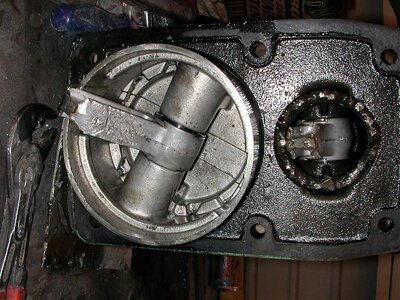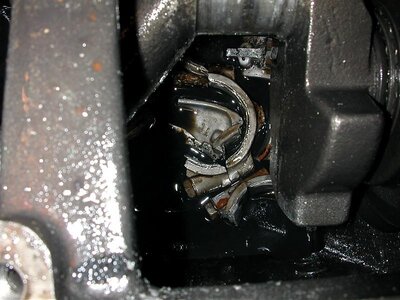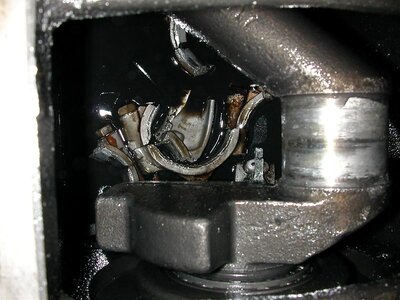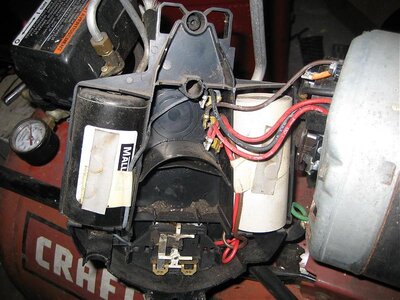You are using an out of date browser. It may not display this or other websites correctly.
You should upgrade or use an alternative browser.
You should upgrade or use an alternative browser.
Fast Way To Burn $600
- Thread starter Bonzia Bob
- Start date
Yup, that's what happens. Check the oil weekly.
I must see atleast 1 a month like that. You would be surpised how many car dealers blow up compressor for not checking the oil. We now install low oil shut switchs to prevent that problem.
If you give me make & model I may be able to get you the parts.
I must see atleast 1 a month like that. You would be surpised how many car dealers blow up compressor for not checking the oil. We now install low oil shut switchs to prevent that problem.
If you give me make & model I may be able to get you the parts.
hangtime
Speak up ,don't kiss azz
- Location
- WORCESTER,MASS- HAMPTON N.H.
Didn't you read the owners manual when you bought it .It clearly states to regularly check your oil .
As a matter of fact it's a good idea to check the oil on any engine that HAS oil .
Let me go check mine right now :cool2:
As a matter of fact it's a good idea to check the oil on any engine that HAS oil .
Let me go check mine right now :cool2:
WaveDemon
Not Dead - Notable Member
- Location
- Hell, Florida
Yup, that's what happens. Check the oil weekly.
I must see atleast 1 a month like that. You would be surpised how many car dealers blow up compressor for not checking the oil. We now install low oil shut switchs to prevent that problem.
If you give me make & model I may be able to get you the parts.
hey scorn, I've got a crappy consumer model oil-less air compresson that makes a buzzing noise and flips a circuit breaker. what should I check for to see if it's repairable?
It didn't have many hours on it and I've already replaced it but I'd like to use it as a vacuum pump for another project.
Last edited:
Its an old Speedaire, but I already bought a new compressor pump. I will keep you in mind the next time I need parts for one though, thanks!:biggthumpup:
FX-6.9 Boy
VILLIGE IDIOT
we don't check oil.........we're two stroke guys...........
hey scorn, I've got a crappy consumer model oil-less air compresson that makes a buzzing noise and flips a circuit breaker. what should I check for to see if it's repairable?
It didn't have many hours on it and I've already replaced it but I'd like to use it as a vacuum pump for another project.
Does your compressor have a tank?
Does it trip the breaker after it's cycled once? Once the unit is done running you should hear a little air blow out.
A compressor needs to unload after it finishes it duty cycle so no air is left in ths cylinder. That air in the cylinder will put a load on the motor and cause it to trip breaker. You could have a bad check valve allowing air to leak back to the cylinder or the unloader may be badand not letting the left over air escape.
Hope this helps. If you have more questions I'll pm you my number and I can talk you through the problem
We do a lot of repairs for Grainer on all there Speedaire & Dayton compressors. Most are now made by Champion but have the Speedaire nameIts an old Speedaire, but I already bought a new compressor pump. I will keep you in mind the next time I need parts for one though, thanks!:biggthumpup:
WaveDemon
Not Dead - Notable Member
- Location
- Hell, Florida
Does your compressor have a tank?
Does it trip the breaker after it's cycled once? Once the unit is done running you should hear a little air blow out.
A compressor needs to unload after it finishes it duty cycle so no air is left in ths cylinder. That air in the cylinder will put a load on the motor and cause it to trip breaker. You could have a bad check valve allowing air to leak back to the cylinder or the unloader may be badand not letting the left over air escape.
Hope this helps. If you have more questions I'll pm you my number and I can talk you through the problem
I havn't used it in a year or so. the the tank (25 gal) is emptied and still wouldn't run at all. send me your number if it's easier.
Last edited:
#ZERO
Beach Bum
- Location
- Florida - U.S.A.
Ouch !
Some of the more expensive compressors have a oil level shut of switch.
Some of the more expensive compressors have a oil level shut of switch.
Idok
F1pro
- Location
- Nations oldest muthaF+++kin city
If the motor just humms. Your motor probally has a bad starting capasitor.
You can try getting a replacement from Grainger or a Electric motor parts house.
my ac died last summer and that was the problem then...you could hear it TRYING to start..and it'd run if you started the fan by hand, but the capacitor wasnt charging.....
WaveDemon
Not Dead - Notable Member
- Location
- Hell, Florida
I'll pull the thing out of the shed tonight and into the garage and start taking some of the plastic covers off. is there a way to test the capasitor without shocking the crap out of myself?
Orv9978
X
- Location
- New Smyrna Beach
Just take a rubber handled screwdriver or pair of pliers and put it across the 2terminals on the capacitor if it sparks then the charge is released if not there is probably no charge on it. Of course make sure there is no power applied to it when you short out the two terminals. Don't know if you have a meter to test microfarads but most digital meters have a symbol on them(uF) which stands for capacitance and you can test the capacitor that way. If you need a new one and can't find one in your area let me know I can get just about anything electrical at the place I work and can ship it to you.
Make sure you disconnect the wires to it before testing.....
Make sure you disconnect the wires to it before testing.....
WaveDemon
Not Dead - Notable Member
- Location
- Hell, Florida
Just take a rubber handled screwdriver or pair of pliers and put it across the 2terminals on the capacitor if it sparks then the charge is released if not there is probably no charge on it. Of course make sure there is no power applied to it when you short out the two terminals. Don't know if you have a meter to test microfarads but most digital meters have a symbol on them(uF) which stands for capacitance and you can test the capacitor that way. If you need a new one and can't find one in your area let me know I can get just about anything electrical at the place I work and can ship it to you.
Make sure you disconnect the wires to it before testing.....
I pluged in my compressor with the cover off and I can see it turns over slowly (maybe one revolution) and then blows a fuse. attached is a pic of some of the electrical parts. I figure one or possibly both of the cylinders are the capasitor(s). there was a mud dobber nest on the contacts on the bottom. I hopped that was the problem but it doesn't seem to be.
WaveDemon
Not Dead - Notable Member
- Location
- Hell, Florida
any advice? crap. I forgot to add the picture to my last post. I'll post it up when I go home for lunch.
LBE
Eddie Would Go.
- Location
- Charlotte, NC
we don't check oil.........we're two stroke guys...........
I just pre-mix also
Orv9978
X
- Location
- New Smyrna Beach
any advice? crap. I forgot to add the picture to my last post. I'll post it up when I go home for lunch.
Sounds like there is a start and a run capacitor both. The start capacitor will have a low microfarads and a high microfarads written on it along with voltage for a rating. (Ex.124-175uf, 370V)The run will only have a single microfarads with voltage written. (Ex. 45uf @440v)
If you cannot see them or get to them I can try to look up the manufacturer of the motor to tell you the ratings on them...
WaveDemon
Not Dead - Notable Member
- Location
- Hell, Florida
thanks, I still havn't tested them. should I plug it in briefly (then unplug) before I test them?Sounds like there is a start and a run capacitor both. The start capacitor will have a low microfarads and a high microfarads written on it along with voltage for a rating. (Ex.124-175uf, 370V)The run will only have a single microfarads with voltage written. (Ex. 45uf @440v)
If you cannot see them or get to them I can try to look up the manufacturer of the motor to tell you the ratings on them...
attached is the pic.
Attachments
Orv9978
X
- Location
- New Smyrna Beach
thanks, I still havn't tested them. should I plug it in briefly (then unplug) before I test them?
No don't plug it in you don't want a charge on them or you will get a nice shock. I have never had one hold a charge though in three years in commercial refrigeration work though. just make sure you take the screwdriver across the terminals first in case there is a charge in one of them.
Also take the wires off the capacitor or wherever they are connected. You can test them from the end of the wires or right at the capacitor as long as they aren't connected to anything...
From the pic the one on the left is definatly a capacitor as for the one on the right it may or may not be would have to look at the writing on it....




